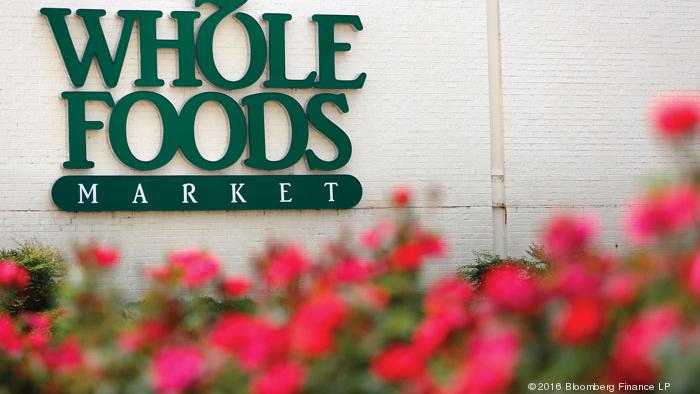Whole Foods' woes offer a cautionary tale for Publix
Jul 29, 2016, 7:39am EDT Updated Jul 29, 2016, 10:36am EDT
Ashley Gurbal KritzerSenior ReporterTampa Bay Business Journal
Whole Foods Market Inc. reported another less-than-stellar quarter this week, and within its disappointing results are lessons for other grocers like Publix Super Markets Inc.
Whole Foods' same-store sales — which do not consider sales growth from new stores — fell 2.6 percent in the quarter that ended July 3. The organic grocer blamed the declined on competition from mainstream grocers like Publix andKroger Co. (NYSE: KR), which have stepped up their organic and specialty offerings in recent years.
Whole Foods Market/LUKE SHARRETT
And while Publix is currently thriving — and growing rapidly into North Carolina and Virginia— it isn't immune from the problems that have tripped up Whole Foods. Austin, Texas-based Whole Foods has been working for the last year to shed its "Whole Paycheck" reputation, with mixed results.
"I think there is a cautionary tale for everybody in the area of pricing," said Jim Hertel, senior vice president at Willard Bishop and Inmar Analytics Co., a Chicago-based food retailing consulting firm.
Publix, Hertel said, faces the same industry headwinds as other big grocers — new concepts and increasing competition from meal kits and prepared food services — but Publix also isn't known for low pricing, especially compared to Kroger and Walmart Stores Inc. (NYSE: WMT)
"They’re obviously a retailer who focuses more, in my assessment, on service and and other things like quality," Hertel said, "rather than being the guys who have the hot weekly circular every week."
Presenting another challenge for Publix is smaller but up-and-coming grocers like Aldi and Sprouts Farmers Market (NASDAQ: SFM), both of which do focus on pricing and have plans to expand in the Southeast.
While Aldi has been in the U.S. since the mid-1970s, the German discount grocer really flourished during the Great Recession, Hertel said — and never relinquished the middle- and upper-middle class shoppers it gained during the downturn.
"Between same-store sales growth and new stores, Aldi is probably the hottest mainstream food retailer right now," Hertel said.
But it wouldn't be enough for Publix to just cut prices, Hertel said, or even ramp up its bundling offers, like the "buy one get one free" deals Publix is known for. For Publix to stay on its current growth path — 2015 revenue was $32 billion, up from $30 billion in 2014 — it also has to stay ahead of consumer tastes.
Meal kit delivery services like Blue Apron, for example, are emerging as a competitor for grocers. Market District, an upscale concept from Pittsburgh grocer Giant Eagle, has launched its own meal kits.
It's that type of innovation, Hertel said, that will determine which grocers succeed in the future.
"If you look at it and say, 'We're going to justify our higher price points,' the way to do that is to constantly raise your game in terms of what you're offering to the consumer," he said. "There’s not going to be one answer to it."
Every grocer, Hertel said, is looking for ways to keep up with competitors to Amazon's growing grocery services.
"People are going to have to go smarter and harder just to keep pace," Hertel said. "I guarantee you Wegmans is wondering what’s next, too. So there’s always somebody who’s going to go maybe a step ahead and figure out."

Happy New Year 2019 Poems
ReplyDeleteNew Year Images 2019
Happy New Year 2019 Poems
ReplyDeleteNew Year Images 2019